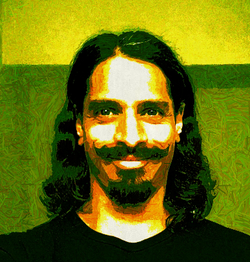Pantheism is the identification of divine presence within Nature and the Universe. It does not support an anthropomorphized deity in the sense of a "white haired Zeus-like god", but rather recognizes patterns, behaviors, vibrations, and frequencies in nature as linked to a universal presence, while dismissing the phenomena of coincidence.
Discovering coinciding patterns of overlap in relation to their statistical odds of occurrence is akin to witnessing a rainbow while listening to nature. It may be regarded as a divine sign or dismissed as an inevitable scientific probability. Either way, the observance of such phenomena can be interpreted by one's attitude towards faith in the Divine.
I once kept a 'coincidence' journal where I began recording such instances in order to track if I was manifesting such seemingly strange and highly unpredictable circumstances. This experiment led me to discover the concept of synchronicity, developed by philosopher/psychiatrist Carl Jung. The concept of synchronicity deals with the occurrence of two or more events that seem significantly related without causal relationship. In other words, synchronicity becomes the observation of meaningful 'coincidence' in complex patterns of frequency that do not seem to be randomly occurring or self-manifesting. Philosopher and writer Paulo Coelho wrote in his book The Alchemist that synchronicity is like the communication between the Universe and man.
“And, when you want something, all the universe conspires in helping you to achieve it.”
― Paulo Coelho, The Alchemist
Synchronicity begins to form when one observes and follows patterns of coincidence like a trail of bread crumbs leading along a path. Sometimes these coincidences have easily discernible meanings, and other times they are quite abstract. Like all things, these observations of synchronicity are only as real as the energy one supplies it. If one chooses to dismiss such occurrences in favor of scientific probability then the trail usually stops there. I suspect that synchronicity works best with those who are tuned in to receive signals like a radio antenna.
Psychology teaches that people form mental schema(s) or schemata that are like large networks of categorized information or maps that serve as a decision matrix. These mental schemas are like shortcuts our brain uses to help us make quick choices about our behaviors in a new situation. In ancient days, our ancestors relied on the knowledge of hunting patterns of various animals so as to seek protection or know when to hunt themselves. They learned the patterns of the seasons to know when to plant or harvest their crops. In other words, they had to develop strategies for quick thinking when making survival decisions and to keep them out of trouble. Today when people are confronted with a situation where they must make a decision, our brains process the information and elect the best option for behavior like picking directions on a map. Each choice brings a new path which can lead us off course or bring us closer to our destination.
Symbols are assigned value based upon what they represent to an individual. With enough energy given to a symbol by enough people, these emblems become powerful messages that convey stories of information within a simple design. Jung coined the term the "collective unconscious" in reference to the energy given and shared by the people who assign value to symbols. It suggests that all humans share structures of the unconscious mind populated by instincts and archetypes or universal symbols. These symbols have a profound influence on an individual as they clothe their representations in meaning. These symbols can serve to remind one to stay focused on the path they wish to follow. Each of us are on our own respective journey; therefore, the symbols we value may differ from the symbols that others use so it becomes important to recognize the equal sanctity each symbol represents. (For example, the cultural greeting of 'Namaste': My divinity recognizes yours).
We use symbols and schemata to help us with our decision making to keep us on course to reaching our goals and destination. These signs, symbols, and coincidences may be found everywhere. They take practice to identify and accept. In the children's story of Hansel and Gretel, the children left a trail of bread crumbs in the forest to lead them back to safety when they were abandoned. Instead of birds eating the trail of 'crumbs', the Universe leaves a trail of 'coincidence' or synchronicities for us to find and if we so choose to follow. The notion that there are no coincidences implies that a level of predeterminism exists. It suggests that everything happens for a reason and all that has been, is currently, or will be is part of a cosmic plan. Some are uncomfortable with the idea that free will and choice cannot exist concurrently with the concept of destiny; however, one way of seeing things is to understand that all souls are on a journey to a destination that humans instinctively feel to a place without suffering. This journey may be masked in the form of evolution as our soul-bound bodies continue to change and grow throughout time, and the destination may not be an actual place, but a state of being where our collective unconscious may transcend into one collective soul.
“God does not play dice with the universe.”
― Albert Einstein, The Born-Einstein Letters 1916-55



 RSS Feed
RSS Feed
